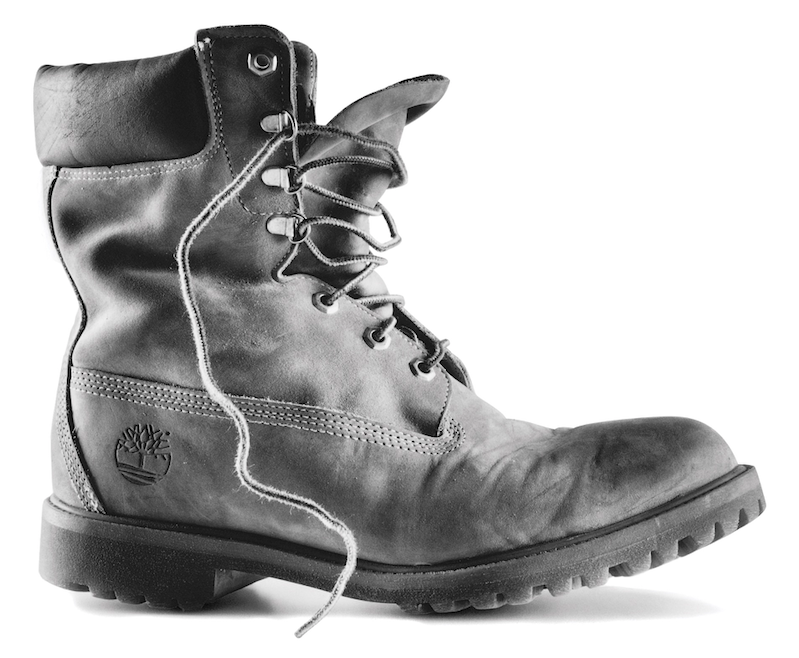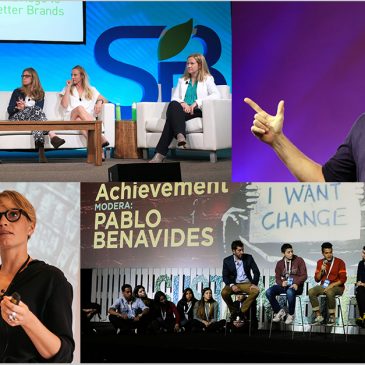Blog
The We First Guide to SB’17 Detroit

We First CEO Simon Mainwaring sat down with the Sustainability Director of Timberland, Colleen Vien, to discuss how the global apparel industry leader is able to create business growth through activating its purpose. The following are excerpts from that webinar, which can be watched in its entirety here.
SIMON MAINWARING: It’s a special webinar today because our guest is Colleen Vien, the Sustainability Director at Timberland. It’s a rare opportunity to tap into the insights and learnings of a leading global brand — not just in the footwear and apparel category, but in terms of their sustainability leadership around the world. I think very few of us realize how purpose has always been built into the origin story of the Timberland brand. Could you speak to us a little bit about where the brand began and how that’s informed its marketing ever since?
COLLEEN VIEN: The company started back in the ‘70s and in 1973 was when they designed that famous icon boot — the Yellow Timberland Boot. Now, that boot was designed intentionally for one thing: to allow people to strap it on and be able to step outside, get work done and to make something happen. From the very beginning, it had a very strong purpose.
That led to [ three generations of family leadership ] for the first 30 years. Nathan Swartz was the individual that created that innovative Yellow Boot — the first truly waterproof boot that didn’t have a bootie on the inside. His legacy, then, was that innovation, thinking outside the box and problem solving. His son, Sidney, comes along, and his legacy was to take that business and make it global. Back in the day, people weren’t putting brands on their footwear. This was even before the Nike swoosh. He wanted to actually take a boot and put the branding iron on it.
Then his son, Jeffrey Swartz, comes along, and he says to himself, “Well, what’s my legacy to the company?” He felt very firmly that commerce and justice could live together and that businesses should be about giving back and not just making a product. So, how do we not just reduce our environmental impact, but how do we actually make the world a better place? So, right from the beginning, purpose has been there.
Then, we went into a new generation of leadership when we were acquired by VF Corporation in 2011. What’s great about the new journey that we’re on is that we have the support behind us of a large company like VF Corporation, who truly believes that without being purpose-led, your business can’t grow.
We’ve also had CSR in place for 25 years. Specifically, our Path of Service for employees to do community service hours with paid time off to do that. We’ve been doing this for a long time, but we didn’t really have a good, strong way to articulate and message it, both internally and externally. And now we just worked together to create our newly refined and refreshed purpose statement which is: To inspire and equip the world to step outside, work together, and make it better.
SIMON: I took away three very important things from what you just shared.
The first is the product was designed specifically to have a purpose — some meaningful purpose in the first place. Second, you didn’t have to earn leadership buy-in. Leadership buy-in was a given. It was a permission slip for the entire company to be more purposeful and to lead with purpose. Third, the articulation of the purpose itself. It’s one thing to have an instinct to be a purposeful brand. It’s another to really articulate what that is to guide your company, inside and out.
Moving on, how do you see purpose showing up in a way that helps build the business in an authentic way?
COLLEEN: I’ll give you two versions of an answer to that: what we’ve been doing and what we aim to do. We’ve now done over a million hours of community service across the globe. We’ve planted almost 10 million trees across the globe. We’ve worked very hard to put sustainable materials into our products. We’ve been doing it because we know it’s the right thing to do. We haven’t really been talking about it and telling that story and engaging our consumers in that journey with us as much as we could. And that’s going to change moving forward.
The strongest growth driver as a result of being purposeful inside our company and living our values every day is that we attract and we retain like-minded individuals that believe that our brand is about more than products. We’ve been able to keep some really strong talent as a result of that, and we’ve also seen it be very powerful in connections with our customers. So, we invite them to strap on their boots and step outside and do some community service together. That has forged some really powerfully strong relationships.
SIMON: That shared experience of impact and contribution forges a different bond with your partners in business. Building on that, how do you calibrate the brand’s different regions around the world?
COLLEEN: The products do show up a differently in each region, but we see our consumers as being kind of three different types of individuals: the true outdoor enthusiasts that enjoy hiking, fishing and outdoor experiences to its fullest. Then, a lot of our consumers are urban dwellers that are not necessarily out in the big outdoors all the time, but in their everyday lives, stepping outside and enjoying whatever they can within their own community. Finally, we have some of these younger, more hip and cool consumers.
Further, when we did the research across all of the regions about those consumer targets, we also asked them about purpose. What we saw was that no matter where they were, each one of those consumer types agreed on one thing. If you’re a true outdoor enthusiast, you understand the impact of business on the planet and you want to see that impact reduced. For our more urban consumers and for our younger, street-savvy fans, they really want to connect with brands that have purpose and are active in their communities
So, now we are going to bring our purpose to life in different ways, and while it should be regionally-focused and unique for each of those regions, at the end of the day it’s all laddering up to one thing about how nature needs us. Whether it be human nature or whether it be Mother Nature, we need to step up, we need to step out and work together and make it better.
SIMON: How does sustainability inform your product innovation on an ongoing basis?
COLLEEN: We recognized that the largest environmental impact of our products was the leather. We went after that first and helped to co-found what exists today as the Leather Working Group, which is a best-in-class environmental audit protocol that now tanneries are being asked to have done. So, brands like Timberland are saying they’re only going to do business with a tannery if it’s able to achieve a silver or gold rating from that audit protocol.
Then, back in 2007, we wanted to see what would happen if we built the most sustainable boot that we could using sustainable materials — recycled, organic, renewable, silver and gold rated leather, recycled rubber. We built this boot called the Earthkeeper Boot, and it did phenomenally well. It was the only boot that ever outsold the Yellow Boot in a single year, ever in history. And before you know it, we had over 80 percent of the products in market were being branded as Earthkeeper products, because we had proven that model out. And now, all of our products, all SKUs, are required to meet what is, in essence, the Earthkeeper standards that we had put forth prior for that one boot.
SIMON: Many brands face at some point the choice between doing something that is profit-driven and doing something that’s more purpose-driven. What happens inside Timberland when you’re at a crossroads?
COLLEEN: I really want people to understand that if at first it is cost-prohibitive, don’t give up, right? You need to continue to think innovatively and you need to find other ways. There’s been lots of examples in our history where if we couldn’t find cost-effective and quality, performance-driven recycled rubber in the supply that we wanted, we didn’t just give up on that idea. We went and we partnered with the tire industry to then create a new rubber compound that they would start to use, so that then we would actually have the kind of recycled rubber that we want to be using.
I think that’s a really key learning that I’ve experienced personally here at Timberland is that sustainability doesn’t have to be a barrier. It doesn’t have to bring in more cost or more restrictions or more requirements. It’s really about innovation and how do we solve for problems? And maybe you don’t solve it by yourself. You partner with people, even if they are competitive within your industry.
How do you make those decisions? Well, first of all, there’s definitely going to be things that you would just never do, right? We’re not going to source our products from factories that have child labor. We’re not going to use a tannery that’s polluting the river behind them. So, we ask how do we make purpose a part of driving the profits and engaging more consumers?
SIMON: Is there any learning on the way that you might share with younger, newer companies coming into this space?
COLLEEN: We’ve had campaigns that were very specifically about purpose, stemming back to ‘Give Racism the Boot’ — a very large ad campaign that we did that was very controversial back in the ’80s. And more recently in the early 2000s with Nature Needs Heroes. It was disappointing to see how those ad campaigns didn’t resonate in terms of the traditional marketing metrics that the business was looking for, and so both of those campaigns got dropped pretty quickly after one season.
That’s become the challenge that we’ve had to reprogram ourselves in terms of thinking about marketing. If you don’t continue to tell that message continually, season over season, you’re not going to have an identity or you’re going to look schizophrenic, and you’re going to be a different personality each season. So, that’s what we have actually had to overcome internally is how do we look at the return on these messages, when they are truly about purpose?
And now we’re ready to do that. It’s going to be something that we’re going to be saying season over season, and it’s going to take a little while for the marketing metrics to show what traditional marketing metrics are looking for. That’s my advice to everyone is that you need to be consistent in what you’re saying, but you need to also be authentic in what you’re saying and demonstrate it multiple times — over and over and over because it’s through that repeated, consistent action of authentic action that builds brand loyalty.
SIMON: Is there one particular example of all the things that Timberland does around the world that personally you’re excited about?
COLLEEN: So, we’ve been planting trees for decades, right. We didn’t start counting the trees when we first started planting. That’s a lesson to be learned too: measure your impacts! So, when we started tracking, though, we’re now up to almost 10 million trees. Through consumer insights research, we learned that — your logo is a tree, you plant trees, that makes a lot of sense. It’s good for the planet, it’s good for the climate, but it just feels so far and distant, you know? What about right here in my own backyard? That was an “aha moment” for us. If we really want to invite our consumers onto the journey with us, we need to be doing initiatives that are more accessible to them. Our projects should be ones that they’re the benefactors of. So, for example, Urban Greening was launched three years ago. We’re in our third year of our commitment right now where we set a public goal to be doubling our footprint in five major markets in five years.
The second example of what I’m really proud of is our tree planting in Haiti. In 2010, just before the earthquake hit there, we had learned of the deforestation magnitude in Haiti and said, you know, if anywhere needs planting trees, this country needs it. But as a result of the earthquake and understanding more about the poverty that also was rampant in that country, we wanted to plant these trees in a way that wasn’t just about digging a hole and putting a tree in the ground and helping Mother Nature. We really wanted to think about that human nature.
So, we found this partner called Smallholder Farmers Alliance. Together, we crafted this program where, by way of planting trees, smallholder farmers are improving their crop yields and improving their revenue, their economic income, sending kids to schools for the first time. The first round that we did was a five-year commitment. We planted five million trees and improved the lives of 3,400 smallholder farmers. Over 3,000 school kids are now in school as a direct result of this program.
That was a five-year commitment. When that was finished, we also had challenged the Smallholder Farmers Alliance to find a way to make it self-sustaining. They recognized that by planting a particular tree — the Moringa tree — that then became an export commodity for these farmers. They continue to plant a million trees every single year and continue to improve the lives of more and more smallholder farmers.
SIMON: If you could lay out your vision for what you think business will look like in the next 5-to-10 years or the role it would play, where do you see it going?
COLLEEN: We all know that each individual on the planet has a responsibility to leave this planet to the next generation. I think businesses are perfectly positioned to leapfrog forward and start to bringing change in large-scale ways. And the power of it really is going to be when we do get the consumers on that journey with us. That’s when you start to see the behavior changes and people actually choosing to vote with their dollars on those companies that are actually doing and making a difference.
SIMON: If you were to give a cautionary tale to brands that ignore this, what risk do you think they take if they just opt out of playing a meaningful role?
COLLEEN: You can’t opt out. In today’s world the access to information is everywhere. You can’t just sit back and pretend that nobody’s watching because those days are gone. So, you really can’t opt out.

The We First Guide to SB’17 Detroit
Why and How to Become a B Corp

Purpose At Work: How MLB Hits Purpose Out Of The Park

